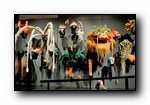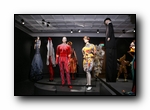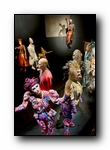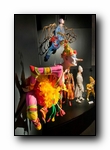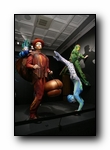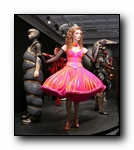
![]()
Création
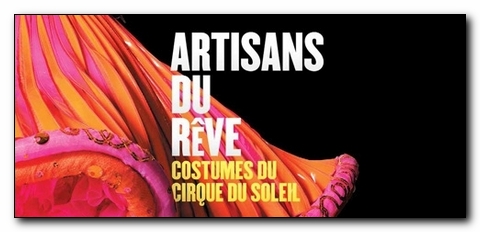
The designer, the artisan and the artist all share a common dream: the show. As they work together, pooling their talents and expertise, the costume takes shape and the character emerges. Three key elements central to this process – passion, complicity and excellence — combine to make magic. These Dream Weavers have been at the heart of the Cirque du Soleil story right from the very beginning. Listen to the tales these costumes have to tell and share in the memories of those who created and produced them. Every costume is a crucible of dreams, passion, expertise and experience, allowing the person wearing it to sublimate his or her own personality and slip into a circus character. Using the keys to imagination and wonder that the costume holds, the character opens a door, allowing the audience to share in the amazement for a brief moment. In keeping with the very essence of Cirque du Soleil shows, tailored to appeal to all audiences, each costume is a minor miracle in itself, the fruit of daunting virtuosity. The work of Cirque du Soleil artisans ranges from one extreme to another, as they play with the staggeringly large and the incredibly small. It is both a physical and a mental challenge, similar in a way to the performances of the artists who risk their lives and bare their souls on stage, show after show.
Unlike the costumes worn in the theatre or opera, Cirque du Soleil costumes are about much more than looks. They have to meet strict technical requirements, for the artists’ acrobatic numbers are extremely demanding. It is this desire to constantly push the boundaries that allows these artisans to continue innovating and exploring new artistic and technical horizons. Thousands of hours creeping or speeding by, and all those hearts and hands. All that work, all those shared efforts, all the artisans’ blood, sweat and tears come together under the spotlights. Thanks to this monumental teamwork, the magic kicks in, the character springs to life, and the audience is transported to another realm. The exhibit presents: Close-ups on costume making:
The designer, the artisan and the artist all share a common dream: the show. As they work together, pooling their talents and expertise, the costume takes shape and the character emerges. Three key elements central to this process - passion, complicity and excellence - combine to make magic. Here the artisans share some of their experiences, their enthusiasm and their secrets, offering visitors confidences, anecdotes and memories, and guiding them as they explore how these "second skins" are fashioned to create a Cirque character. These Dream Weavers have been at the heart of the Cirque du Soleil story right from the very beginning. Now you are invited to fashion your own stories as you admire the different costumes. Follow your instincts, your curiosity and your heart, as you listen to the tales these costumes have to tell and share in the memories of those who created and produced them.
The work of Cirque du Soleil artisans ranges from one extreme to another, as they play with the staggeringly large and the incredibly small. It is both a physical and a mental challenge, similar in a way to the performances of the artists who risk their lives and bare their souls on stage, show after show. Unlike the costumes worn in the theatre or opera, Cirque du Soleil costumes are about much more than looks. They have to meet strict technical requirements, for the artists' acrobatic numbers are extremely demanding. It is this desire to constantly push the boundaries that allows these artisans to continue innovating and exploring new artistic and technical horizons. Here a glimpe at some of the costumes presented in the exhibition: The Baron | Saltimbanco (1992)
"Stripes on a costume always look easy, but every time it's a real puzzle. To make sure the lines fall properly, you have to trace them directly onto the pattern. You also have to keep an eye out for any mismatched lines that might meet at the groin." - Hélène Allard, Textile Designer Firebird | Mystère (1993)
"With the birds in Mystère, we started to show some skin. It was a much more exposed show than Nouvelle Expérience or Cirque Réinventé. The dancers were sexier. It was something new. Even during the fittings, the artists were uncomfortable." - Francine Desrosiers, Costume-Making Specialist Old Birds | Alegría (1994)
"Franco Dragone and I were thinking about the seven capital sins when we worked on the Old Birds. These characters all have great faults: they're fat and ugly and stuck up with what they've got and what they know, they're conceited and they show it." - Dominique Lemieux, Costume Designer The Aviator | Quidam (1996)
"When we were doing research for the Banquines and Égarés for Quidam, we went looking for all kinds of garments and props. And then we tried them out with the cutters and different departments. We dressed up for almost two or three days. Dominique Lemieux was part of this exercise to create the Banquines and then the Égarés. That was my first week with Cirque." - Guy Brassard, Costume Assistant Synchronized Swimming | «O» (1998)
"Originally the Nage bleue costumes were really beautiful, but after two weeks they were completely destroyed, that 's 16 girls having two costumes, one for first show, one for second, so 32 costumes after two weeks were dead. The colour had bleached out, the fabric basically had perished." - Julie Roddham, Head of Wardrobe Ermite & Water Meteor | Varekai (2002)
"You have to check with the physiotherapists and find out just how much weight you can add without interfering with an artist's performance, and make sure he doesn't end up with ergonomic problems." - Peter McNaughton, Senior Cutter Optical Salsa | Zumanity (2003)
"For Zumanity, it was haute couture except that it was also an erotic show. We had to work with bras, or someone who was performing in just a g-string. We worked with all sorts of new materials: latex, vinyl, we patinated vinyl." - Guy Brassard, Costume Assistant White Clown | Corteo (2005)
"There was all kinds of work with pleats, what they call smocking, on our pierrots - we used that a lot for the costumes in Corteo." - Dominique Lemieux, Costume Designer Singer | DELIRIUM (2006)
"It was made out of organza, and all the little twinkling lights were fibre optics interlaced into the dress. When she moved, it created this liquid, aerial effect." - Michel Robidas, Designer Mole | CRISS ANGEL Believe (2008)
"The concept for this evolved a lot. It started out as a cockroach, then a rat, and finally a mole. The idea was that it should be repulsive, something you didn't want to touch. It was prickly and noisy, you really didn't want to get close to it." - Peter McNaughton, Senior Cutter Dance Waver | ZAIA (2008)
"In my visual research I was inspired by the inhabitants of the world's great cities. Modern metropolises are characterized by ethnic diversity - a diversity that young people today just naturally embrace - and that has given birth to a new culture that can be seen in the way people dress. The costumes in ZAIA are a tribute to this eclecticism and this fusion of genres." - Dominique Lemieux, Costume Designer Criquet | OVO (2009) |




